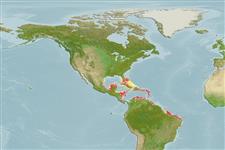Common names from other countries
Environment: milieu / climate zone / depth range / distribution range
Οικολογία
; Υφάλμυρο; εύρος βάθους 2 - 15 m (Ref. 415). Tropical
Western Central Atlantic.
Length at first maturity / Μέγεθος / Βάρος / Age
Maturity: Lm ? range ? - ? cm Max length : 0.2 cm OT αρσενικό/απροσδιόριστο; (Ref. 415)
Encrusting sponge, 0.1 - 0.2 cm thickness. Smooth, and slippery surface, with regularly dispersed oscula: 0.2 - 0.3 cm in diameter. A conspicuous star-shaped canal system surrounds each oscula (Ref. 415). Color: light to dark blue or violet. Leathery (Ref. 85482).
Maximum body thickness: 0.2 cm (Ref. 415). On dead coral in reef environments: 2 to 15 m deep (Ref. 415). Also found in mangroves (Ref. 86836). Favors coral undersides, overhangs, and crevices in shallow and deep reefs and hard bottoms (Ref. 85482).
Life cycle and mating behavior
Γεννητική Ωρίμανση | Αναπαραγωγή | Γεννοβολία | Αβγά | Γονιμότητα | Προνύμφες
Members of the class Demospongiae are hermaphroditic. Life cycle: The zygote develops into parenchymella larva (free-swimming) before settling down on a substrate where it grows into a young sponge.
Collin, R., M.C. Díaz, J. Norenburg, R.M. Rocha, J.A. Sánchez, M. Schulze, A. Schwartz and A. Valdés. 2005. (Ref. 415)
IUCN Red List Status (Ref. 130435)
CITES status (Ref. 108899)
Not Evaluated
Not Evaluated
Threat to humans
Harmless
Human uses
| FishSource |
Εργαλεία
Διαδικτυακές πηγές
Estimates based on models
Preferred temperature
(Ref.
115969): 26.4 - 28.2, mean 27.5 (based on 517 cells).
Vulnerability
Low vulnerability (10 of 100).
Price category
Unknown.
